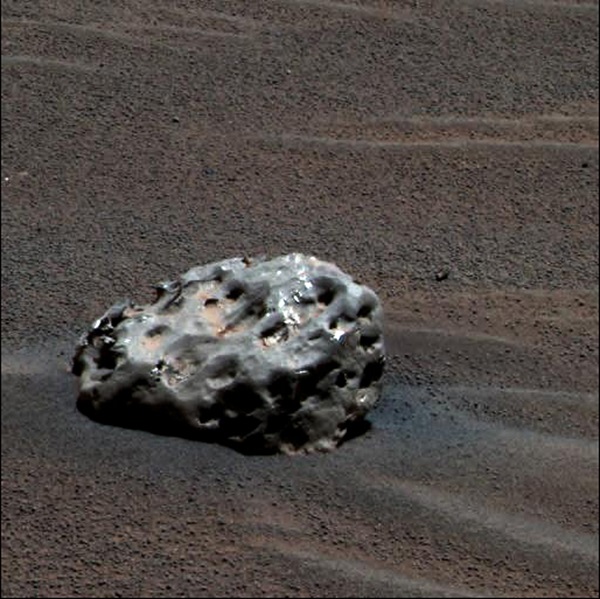Key Takeaways:
Q: What is the mass of the Heat Shield Rock meteorite on Mars? Shouldn’t it have left a crater when it hit? Instead, it looks like it is just sitting “passively” on the surface as if gently placed there.
A: In early January 2005, on the 339th martian day (each day is a “sol”) of its mission, the Mars Exploration Rover (MER) Opportunity discovered a nickel-iron meteorite on the surface of Mars’ Meridiani Planum. It was the first meteorite found on another planet. Because the meteorite lies near the rover’s discarded heat shield, the MER team dubbed it Heat Shield Rock. (Its formal name is “Meridiani Planum,” but many scientists use its informal name.)
The meteorite is 12 inches (31 centimeters) long and shows the characteristic pits, hollows, and voids common in nickel-iron meteorites on Earth. Scientists estimate Heat Shield Rock’s mass is 88 pounds (40 kilograms).
Currently, the meteorite is resting on a flat plain of sulfate-rich sandstone, named the Burns Formation. There’s no sign of a crater near it, and a small drift of wind-blown sand has collected around the meteorite. Scientists have studied the nearby rocky geography, and they believe it erodes relatively easily.
According to planetary researchers, Heat Shield Rock might have landed 3 billion years ago or 300,000 years ago. Scientists have no way to tell for sure. It’s also unclear whether it landed as an individual meteorite, broke off from a larger incoming mass, or survived a crater-making impact.
Heat Shield Rock does have some interesting features. It has an oxide coating that the MER team thinks might be rust instead of a fusion crust, which we typically expect for a meteorite due to its flight through an atmosphere. The meteorite also displays sculpting from wind-blown sand grains. Such details offer glimpses of a harsh environmental history for the region. For example, Block Island (a nickel-iron meteorite about twice the size of Heat Shield Rock discovered in 2009 on Mars) rests on a 2-inch-high (5cm) pedestal of Burns Formation sandstone, which suggests that much rock has eroded from around and underneath the meteorite since it landed.
So why isn’t there a crater at Heat Shield Rock? Long story short, the meteorite landed ages and ages ago, and it’s a great deal tougher than the rocks it’s sitting on.
Mars Space Flight Facility,
Arizona State University










